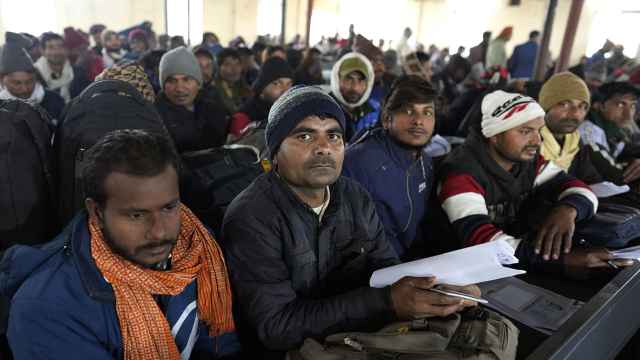Look at the two charts — they show the liquidity in the banking sector and the exchange-rate dynamics over the last two years. They should be pretty frightening, as they both show that Russia's economy is entering crisis territory.
Over the last two months, liquidity in the banking sector has been drying up. It was a liquidity crunch that caused the crash in 2008, and the pink zone in the liquidity chart shows that it went negative in 2009. In other words, the government was forced to bail out the banks to the tune of $66 billion — 10 percent of the country's entire hard currency reserves — to keep Russia's financial sector afloat.
Happily, the Kremlin was successful and the banking sector did survive (unlike in 1998). Hats off to the now-ousted Finance Minister Alexei Kudrin, thanks to whom Russia had about $600 billion in reserves, plenty of money to keep the sector liquid and alive.
Now liquidity is drying up again, and the sector has reached the point where the interbank market will seize up if it reaches zero. If liquidity goes negative again, bankers will start worrying about who is going to go bust and that will mean lending between banks will freeze. That would be bad news as while the biggest 50-odd banks have real businesses, the remaining 950 banks do not and rely on the interbank market, rather than depositors and corporate clients, for funds.
A similar story is shown by the exchange-rate dynamics chart. Despite the high oil price and the positive current account surplus, the ruble's value has been sliding against the dollar and depreciated 14 percent since August. This unsettles depositors and can cause runs on the banks as the exchange rate-savvy Russians (for whom a decade of hyperinflation still smarts) start to withdraw rubles and move them into dollars — which is also a bank-killer.
The Central Bank has already reacted to the weakening ruble, which trades against a de facto peg. Last week, it widened the corridor by 5 kopeks and said that it will continue to add 5 kopeks to the corridor for each $600 million of intervention money it spends on keeping the ruble in the corridor. In other words, the Central Bank is revving up to manage a controlled, slow-moving devaluation of the ruble that will soften the blow of an external crisis and preserve Russia's hard currency reserves: If Greece has a controlled default, Russia will respond with a controlled devaluation.
So are we headed for the abyss? Certainly Russia is in a dangerous place, as confidence is clearly fading fast. It looks increasingly likely that the EU is going to try to ringfence Greece and then let it default — the jolt this would provide to confidence could send Russia over the edge.
And Russian companies are starting to get ready for a crash. Metal companies are reducing inventory and hoarding cash. Banks are also building up their foreign exchange reserves in anticipation of a shortage of the wholesale funding they need to run their businesses, according to bankers.
But if the shock does come, Russia is much better prepared than it was in 2008. The main difference is that this shock has been well telegraphed, whereas the last one was a surprise.
Knowing that a shock is coming is winning half the battle, as one of the reasons that the economy froze in 2008 and hit Russia so much harder than Western economies was that the 1998 devaluation was still fresh in everyone's mind. So they simply stopped doing business until it was clear how the crunch was going to play out; the fact that Russia's economy has bounced back so fast (many of the pre-crisis levels were regained within 18 months) will go a long way to muting the impact of this round of crisis — if it comes.
Secondly, Russia is in a much stronger economic position than it was going into 2008.
Most of the damage was done by the borrowing binge that preceded the 2008 collapse. Russian banks and companies had tapped international capital markets during the boom years. Worse, many companies had used their shares as collateral which led to so-called "margin calls" during the very worst of the crisis.
The way these deals work is that a company borrows, say, $100 million and puts up $100 million worth of shares as collateral. Under the terms of the deal, if the value of the shares falls below, say, $50 million then the company promises to bring the value of the collateral back up to $50 million by paying cash to the lender. The upshot is that, as share prices plummet, companies have to find cash at exactly the time that no one is lending, so they are forced to sell their shares. That only drives share prices down further, creating the need to raise even more cash for the lender. Margin calls started a "death spiral" of forced selling that drove the RTS down to a low of 500 by February 2009 from an all time high of more than 2400 in May 2008.
This time round there will be few, if any, margin calls as the 2008 crisis squeezed all these deals out of the market. Even if companies did strike new deals (and I don't know of any), then the strike price where the margin call kicks in would be a lot lower as the equity market has been so depressed.
Stepping back a bit further, big companies have been starting to borrow again, but a second lesson from the crisis has been that the debt profile of Russian companies and banks is much better than two years ago: Companies have lengthened the maturities of their loans to medium-term debt and at the same time swapped a lot of their foreign borrowing for ruble loans. As the Russian government has plenty of cash and the banks are dominated by the state, the government is in a lot stronger position to restructure debt if a company gets into trouble, as it can all be done "in house."
Alfa Bank issued a report listing the companies that are most exposed to debt and came up with four names: aluminum producer RusAl, the steel mills Evraz and Mechel, as well as pipe maker TMK. RusAl was the worst affected by the last crisis, but this time round it will be the least. The company paid off a large chunk of its debt after it raised just over $2 billion with an IPO in Hong Kong at the start of last year, and it has restructured most of its remaining debt so it does not have a big redemption to make until 2014.
Mechel is in the worst position as it cancelled a planned SPO and is due to redeem $3 billion next year and another $1.6 billion in 2013. Still, $4.6 billion of debt is small potatoes for the state, which has about $540 billion in reserves, if that is the biggest loan it has to cover.
The same is true for all Russia's companies: They have reduced debt or restructured it to longer maturities and borrowed more rubles than dollars. Only a third of RusAl's borrowing is from foreign banks now.
Then there is the economy, which has fared much better this year than anyone would have given it credit for at the start of the year, not that anyone seems to remember the predictions they made then. In January, Kudrin predicted that Russia's deficit would be 3 percent of gross domestic product by December, think tanks like Capital Economics were adamant that the cost of oil would average $50 to $60 this year (the government said $80) and growth forecasts ranged between zero and 4 percent.
The only number Kudrin got right was growth of 4 percent. Oil will average at least $100 this year, and the deficit will probably be zero by the holidays. The result is that the government has rebuilt hard currency reserves to about $540 billion and the reserve funds, supposed to be exhausted by now, will end the year with 4.4 trillion rubles ($145.2 billion) stashed away. Given that the cost to the government of the 2008 crisis was about $200 billion, the money in the reserve fund is probably already enough to pay for a second crisis.
But everything will depend on how well the EU manages the Greek problem. Surely, opting for a controlled Greek default is an extremely risky strategy and one that the less robust and more nervous emerging markets like Russia will not welcome. Banks are built first and foremost on trust, and defaults are by definition a betrayal of that trust — therefore extremely dangerous things. A controlled devaluation is a logistical exercise, but the trouble is that if it is badly managed then fear could get ahead of the control mechanisms; if this fear is large enough, even healthy banks can go bust. There is plenty of room for surprises and these could easily lead to a meltdown.
A Message from The Moscow Times:
Dear readers,
We are facing unprecedented challenges. Russia's Prosecutor General's Office has designated The Moscow Times as an "undesirable" organization, criminalizing our work and putting our staff at risk of prosecution. This follows our earlier unjust labeling as a "foreign agent."
These actions are direct attempts to silence independent journalism in Russia. The authorities claim our work "discredits the decisions of the Russian leadership." We see things differently: we strive to provide accurate, unbiased reporting on Russia.
We, the journalists of The Moscow Times, refuse to be silenced. But to continue our work, we need your help.
Your support, no matter how small, makes a world of difference. If you can, please support us monthly starting from just $2. It's quick to set up, and every contribution makes a significant impact.
By supporting The Moscow Times, you're defending open, independent journalism in the face of repression. Thank you for standing with us.
Remind me later.





